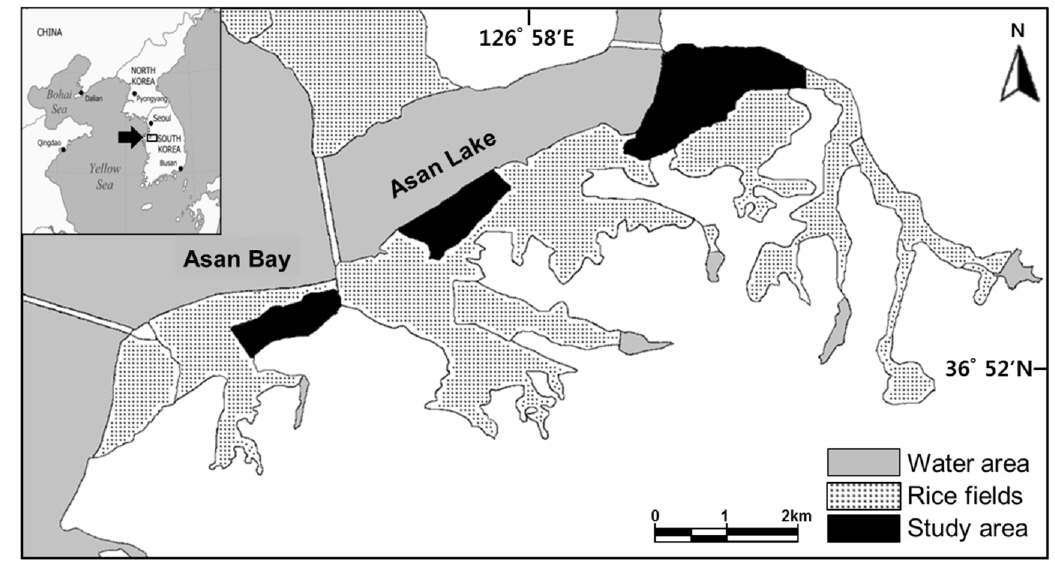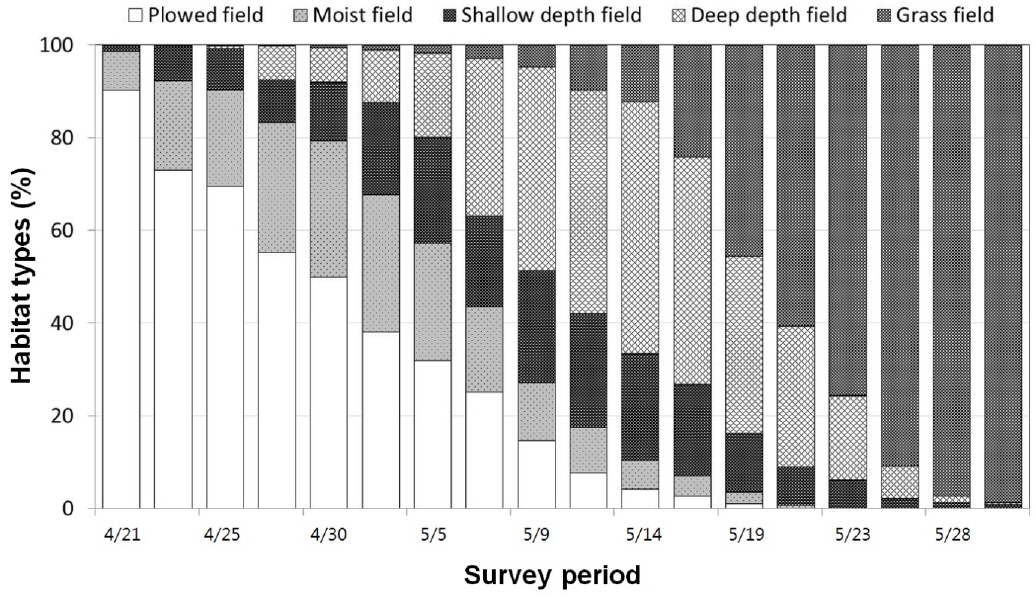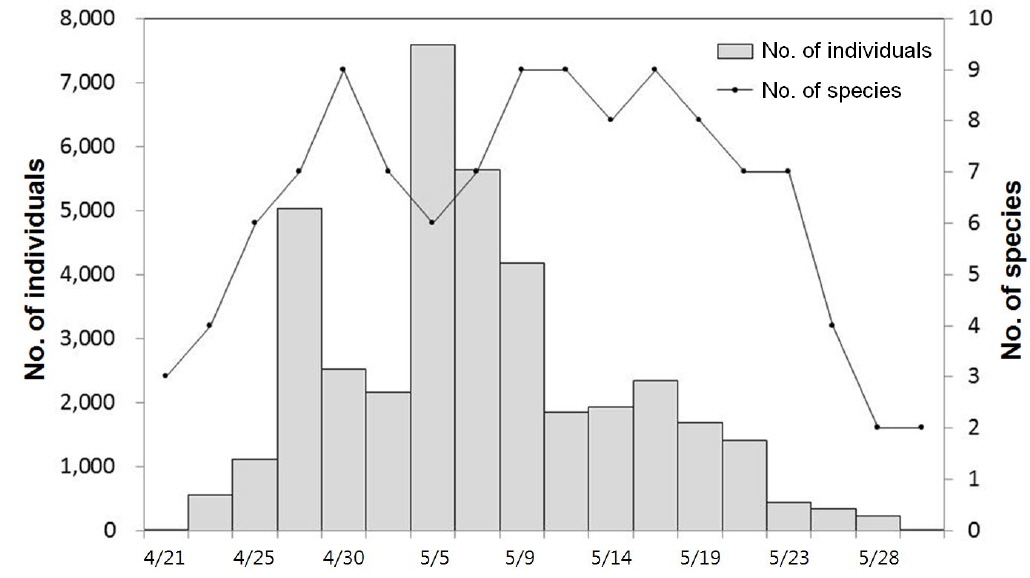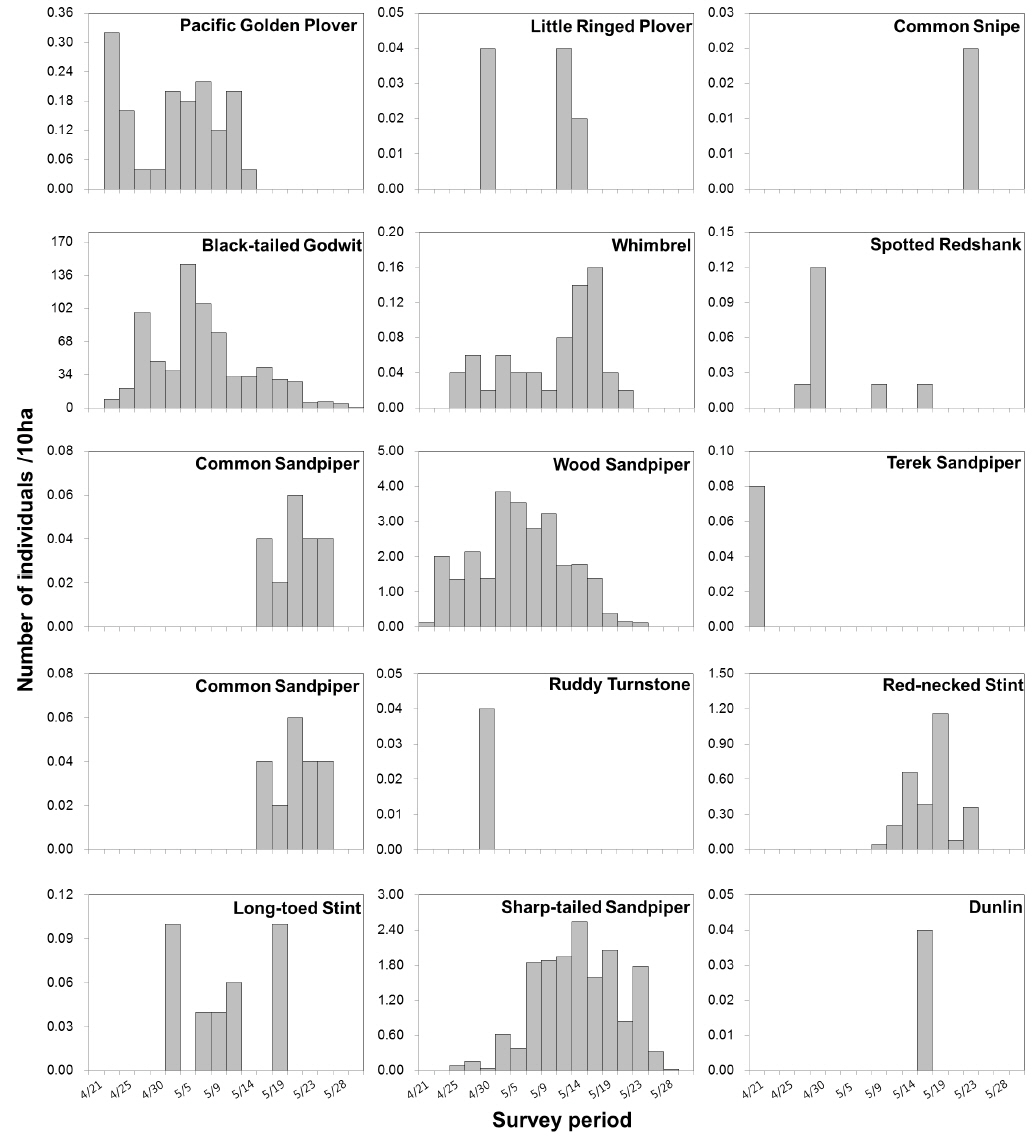



본 연구는 봄철 논습지에 도래하는 도요⋅물떼새류의 도래패턴과 서식지 이용 특성을 파악하고자 수행되었다. 조사는 한국 중서부지역에 위치한 아산만 일대의 농경지에서 2014년 4월 21일부터 5월 30일까지 2∼3일 간격으로 총 18회 수행되었다. 조사 기간 동안 관찰된 도요⋅물떼새류는 총 15종 7,852개체였다. 대상 종들의 시기별 도래 특성은 본답에 물을 대기 시작하는 4월 중반부터 관찰되었고 5월 초까지 지속적으로 종수와 개체수가 증가하는 경향이 나타났으며 5월 후반으로 가면서 종수와 개체수는 감소하였다. 농경지의 물리적 구조에 따른 서식지 이용 특성은 종별 차이가 나타났으며, 대부분의 종에서 본답과 논둑은 수로나 농로에 비해 선호성이 높게 나타났다. 본답의 미소서식지 선호성은 지역 농업인의 농업 관리에 의해 다양하게 나타났으며, 도요⋅물떼새류의 종별 서식지의 선호성 차이가 명확히 나타났다. 대부분 종은 무논의 본답 형태에서 관찰되었고, 써레질 후 5 cm 이하로 물을 얕게 댄 형태인 본답의 이용이 가장 높았다. 반면 물을 대지 않은 건답의 형태인 수확 후 추경한 형태는 이용을 하지 않았다. 결론적으로 봄철 논습지는 도요⋅물떼새류에게 중간 기착지로서 중요한 기능을 하는 것으로 나타났다.
Shorebirds use a variety of wetlands as their stopover sites to replenish energy and nutrient reserves along the migration route. It is increasingly important to understand how birds use the remaining available habitats during migration period, because shorebird stopover sites are often altered and destroyed. Rice fields serve as a major inland stopover site for migrating shorebirds. However, the information on habitat use patterns of shorebirds in rice fields is very limited in Korea. Therefore, we studied the patterns of shorebird abundance and their habitat use in rice fields during spring migration period in western‐central Korea.
Surveys were conducted at interval of 2‐3 days during the spring migration period of 2014 at rice fields of mid‐western Korea. We recorded the location of the observed birds on the rice field map according to the local habitat type. The habitat types were divided by physical structure and cultivation methods. Fifteen shorebird species and 7,852 individuals were recorded during the survey period. The number of shorebird species and their abundance began to increase from the beginning of flooding in late‐April, and reached a maximum in early‐May. After rice transplantation, the number of shorebird species and their abundance dramatically declined. Shorebirds selectively used paddy and levee rather than road and ditch and most species used shallow depth field type. Plowed field types were less attractive to most species.
Flooding rice fields were functioned as stopover sites for a variety of shorebird species during spring migration period. Furthermore, these results provide that the appropriate agricultural practices can be improving the habitat quality for shorebirds.
장거리 이동(long‐distance migration)을 하는 조류개체군은 일정한 경로를 따라 이동하며 여러 형태의 중간기착지(stopover site)를 이용하면서 다음 여정을 위한 에너지를 축척한다(Gudmundsson
도요⋅물떼새류는 장거리이동을 하는 대표적인 철새로 북반구에서 번식을 하고 남반구로 이동하여 월동기를 보내며 다양한 패턴의 이주방법을 선택하여 이주한다. 이주 시 이동경로의 결정과 중간기착지의 선택은 개체군의 생존에 필수적이므로 전략적으로 행동한다(Hedenström and Alerstam, 1997; Colwell, 2010). 한국 중서부지역은 대표적인 도요⋅물떼새류의 이동경로인 동아시아‐대양주 이동경로(EAAF; The East‐Asian Australasian Flyway)에 위치한 국제적인 주요습지로 다양한 철새들의 서식처 및 중간기착지로써 그 중요성이 강조되고 있다(Kim
세계자연보호연맹(IUCN)에 따르면 EAAF 조간대의 생물다양성 감소가 급격히 나타나고 생태서비스가 소실되고 있으며, EAAF 중 특히 황해가 가장 우려되는 지역으로 조사되었다(MacKinnon
EAAF 뿐만 아니라, 전세계적으로 급격한 자연습지파괴 및 조간대의 매립으로 인한 도요⋅물떼새류의 개체수 감소가 심각해지면서 농지, 목초지, 염전 등이 대체서식지로써 가치가 높아졌다(Colwell, 2010). 최근 논습지는 생물다양성 보존에 큰 가치를 지닌 인공습지로, 자연습지의 급격한 감소에 따라 그 중요성은 증가하고 있다(Smith
1990년대가 되어서야 도요⋅물떼새류의 생물다양성에 중요한 지역이(16개의 핵심지역 중 6개가 황해에 위치) 국제적으로 인식되었다(MacKinnon
본 연구는 아산만과 아산호 남단 농업지역에서 수행되었다(Fig. 1). 이곳은 동아시아‐대양주 철새이동경로(EAAF)에 위치하여 다양한 철새들이 대단위로 이용하는 곳이다(Bamford
조류조사는 2014년 4월 21일부터 5월 30일까지 40일 동안 2일 또는 3일 간격으로 총 18회 수행하였다. 이 기간 동안 도요⋅물떼새류는 농경지를 중간기착지로 활발히 이용하는 것으로 알려져 있다(Nam
조사지역 농경지의 물리적 구조와 미소서식지 선호성에 관한 분석은 개체군의 밀도(평균 ± 표준오차)를 이용하여 분석하였다. 출현 빈도가 낮은 도요⋅물떼새류는 서식지 선호성 분석에서 제외하였다. 미소서식지 선호성에 관한 평균 비교는 Kruskal‐Wallis test를 이용하여 검증한 후 유의한 차이가 있을 경우 Bonferroni correction을 이용한 Mann‐Whitney 검증을 통해 집단간의 차이를 확인하였다. 통계프로그램은 SPSS 18.0을 이용하였다.
조사기간 동안 논습지를 이용하는 도요⋅물떼새류는 15종 7,852개체가 관찰되었으며, 이 중 물떼새과(Charadriidae)가 2종, 도요과(Scolopacidae)가 13종이었다(AppendixⅠ). 본답에 물을 대기 시작하는 4월 중반(21일)부터 도요⋅물떼새류가 도래하기 시작하여 대부분의 본답에 물을 댄 4월 말에서 5월 초까지 지속적으로 종수와 개체수가 증가하는 경향이 나타났으며, 모내기 한 논의 비율이 증가하는 5월 중후반으로 갈수록 종수와 개체수는 점차 감소하는 특성을 나타냈다(Fig. 3).
우점종은 조사기간 중 출현한 최대개체수를 기준으로 흑꼬리도요(
종별 도래 패턴을 살펴보면, 흑꼬리도요, 중부리도요(
농경지의 물리적 구조에 따라 도요⋅물떼새류의 종별 이용 형태는 다르게 나타났다(Table 1). 흑꼬리도요, 알락도요, 좀도요, 종달도요, 메추라기도요는 본답의 이용이 크게 나타났으며, 검은가슴물떼새, 청다리도요, 깝작도요는 본답과 논둑 모두 선호하는 것을 확인 할 수 있었다. 중부리도요는 논둑을 가장 선호하는 것으로 나타났다. 대부분의 종에서 수로와 농로에 대한 선호성은 나타나지 않았다.
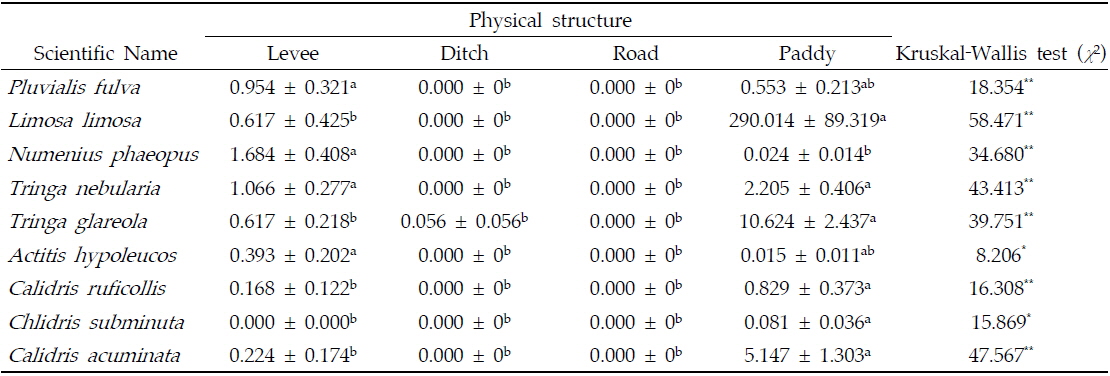
Species preferences for different physical structure in rice field during the northward migration period of 2014
본답의 미소서식지 형태에 따라 도요⋅물떼새류 종별 선호성 역시 다르게 나타났다(Table 2). 대부분의 종이 본답에 물을 대지 않은 건논의 형태인 수확 후 추경한 형태는 선호하지 않았다. 검은가슴물떼새, 알락도요, 좀도요, 종달도요, 메추라기도요는 수심이 얕은 써레질 후 5 cm 이하로 물을 댄 형태의 논을 선호했고, 흑꼬리도요, 청다리도요는 수심에 상관없이 써레질 후 5 cm 이하로 물을 댄 형태의 논과 5 cm 이상으로 물을 댄 형태의 논을 모두 선호하는 것을 확인 할 수 있었다. 검은가슴물떼새와 좀도요는 수심이 얕은 형태의 논뿐만 아니라 추경 후 물을 댄 형태와 모내기 한 형태의 논 역시 선호하는 것을 알 수 있었다.

Species preferences for different habitat types in rice field during the northward migration period of 2014
다양한 도요⋅물떼새류가 내륙 습지인 논을 중간기착지로 이용하는 것을 확인 할 수 있었다(Appendix I). 우리나라 통과철새 중요 도래지 실태 조사에 따르면(NIBR Report, 2011), 전체 중요 도래지에서 관찰된 도요⋅물떼새류 종의 약 44%, 조사 지역에 인접한 중요 도래지인 아산만 지역에 관찰된 도요⋅물떼새류 종의 약 75%를 차지하고 있을 정도로 논을 중간기착지로 이용하는 도요⋅물떼새류 종이 다양한 것으로 나타났다. 중간기착지는 도요⋅물떼새류에게 장거리 비행에 의해 소모된 에너지를 안전하게 회복할 수 있도록 하는 기능을 한다(Colwell, 2010). 일반적으로 많은 도요⋅물떼새류가 대륙의 해안선을 따라 이동하며, 조간대를 일차적인 중간기착지로 이용하는 것으로 알려져 있다(Recher, 1966; Bengtson and Svensson, 1968). 그러나 이러한 조간대 서식지는 만조로 인하여 도요⋅물떼새류들이 주기적으로 이용이 불가능하므로 이에 상응하여 다양한 내륙습지를 취식지로 이용한다(Long and Ralph, 2001). 그리고 악천후 기간 동안 논을 취식지로 이용함으로써 에너지를 회복하기도 한다(Goss‐Custard, 1969; Townshend, 1981). 본 연구결과는 내륙습지인 논이 다양한 도요⋅물떼새류에게 중요한 중간기착지로서 기능을 가짐을 보여준다.
본 연구에서는 담수논 조성 시기에 도요⋅물떼새류가 논습지에 도래하기 시작하는 것을 확인 할 수 있었다(Fig. 2). 이는 물이 유입된 논은 자연습지와 유사한 기능을 가져 수조류에게 중요한 취식지를 제공하기 때문이다(Fasola and Ruiz, 1996; González‐Solís
도요⋅물떼새류는 논의 물리적 구조 중 본답과 논둑을 각기 다른 기능을 가진 서식지로 이용하는 것으로 보인다. 본답과 논둑은 수로나 농로에 비해 도요⋅물떼새류가 크게 이용하는 특성을 확인 할 수 있었다(Table 1). 본답은 다른 물리적 구조에 비해 넓은 면적과 함께 실질적으로 물이 유입되어 저서무척추동물을 부양하는 곳이기 때문에 취식지로서의 기능이 높게 나타난 것으로 판단된다(Maeda, 2001). 논둑은 다른 물리적 구조보다 높게 위치하여 시야확보가 용이하기 때문에 취식 이외에도 경계활동의 공간으로 활용되는 것으로 생각된다. 실제로 조사기간 동안 논둑에서 경계행동을 하는 도요⋅물떼새류를 쉽게 관찰 할 수 있었다. 수로와 농로는 현대화로 인해 대부분이 콘크리트로 포장되어 도요⋅물떼새류의 다양한 먹이원이 안정적으로 서식할 수 있는 공간이 되지않기 때문에 이용이 현저히 낮은 것으로 생각된다.
본답은 지역농업인의 관리에 의해 서로 다른 형태를 나타내며, 도요⋅물떼새류에게 다양한 서식지를 제공한다(Nam
도요⋅물떼새류가 도래하는 기간의 본답은 크게 수심과 토양의 상태에 따라 여러 형태를 나타낸다. 이렇게 형성된 다양한 서식지는 도요⋅물떼새류 종별 이용에 명확한 차이를 나타낸다(Table 2). 이러한 차이는 선호하는 취식 방법과 형태적 특성에 의해 결정되는 것으로 생각된다. 일반적으로 도요⋅물떼새류의 취식방법은 크게 시각에 의존한 취식(visual feeding)과 촉각에 의존한 취식(tactile feeding)으로 나눌 수 있다(Krupa
인간의 개발로 인하여 도요⋅물떼새류가 이용하는 다양한 형태의 중간기착지들이 사라지거나, 파괴되고 있다. 그에 따라 도요⋅물떼새류의 서식지 이용과 관련된 특성을 이해하는 것은 도요⋅물떼새류의 보전 전략 수립에 중요하다(Davis and Smith, 2001). 본 연구는 논에 도래하는 도요⋅물떼새류의 시공간적인 분포 형태를 구체적으로 파악한 논문으로 보전 전략 수립에 정보를 제공하는 것에서는 중요한 의미를 가진다. 그러나 본 연구는 도요⋅물떼새류의 일반적인 특성에 대한 기초자료를 제공하고 있다는 한계점도 가진다. 따라서 향후 먹이자원과 관련한 도요⋅물떼새류의 서식지 이용특성이나 지역농업인의 관리와 이용 패턴의 구체적인 관련성 등에 관한 연구를 통해 좀 더 세부적이고 체계적인 관리방안을 모색하는 것이 필요하다.

